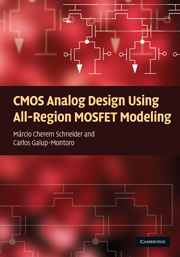Book contents
- Frontmatter
- Contents
- Preface
- 1 Introduction to analog CMOS design
- 2 Advanced MOS transistor modeling
- 3 CMOS technology, components, and layout techniques
- 4 Temporal and spatial fluctuations in MOSFETs
- 5 Current mirrors
- 6 Current sources and voltage references
- 7 Basic gain stages
- 8 Operational amplifiers
- 9 Fundamentals of integrated continuous-time filters
- 10 Fundamentals of sampled-data circuits
- 11 Overview of MOSFET models and parameter extraction for design
- Index
Preface
Published online by Cambridge University Press: 17 December 2010
- Frontmatter
- Contents
- Preface
- 1 Introduction to analog CMOS design
- 2 Advanced MOS transistor modeling
- 3 CMOS technology, components, and layout techniques
- 4 Temporal and spatial fluctuations in MOSFETs
- 5 Current mirrors
- 6 Current sources and voltage references
- 7 Basic gain stages
- 8 Operational amplifiers
- 9 Fundamentals of integrated continuous-time filters
- 10 Fundamentals of sampled-data circuits
- 11 Overview of MOSFET models and parameter extraction for design
- Index
Summary
Analog integrated circuits in bipolar technology, beginning with operational amplifiers and advancing to data conversion and communication circuits, were developed in the 1960s and matured during the 1970s. During this period, the metal–oxide–semiconductor (MOS) technology evolved for digital circuits because of its better efficiency in terms of silicon-area use and power consumption compared with bipolar digital technologies. To reduce the system cost and power consumption, chips including digital and analog circuits appeared in MOS technology in the late 1970s. The first analog circuits in MOS technology were for audio-frequency applications. With the scaling of the MOS technology, driven by the need for large-scale integration levels, enhanced performance and reduced cost, even radio-frequency (RF) applications in MOS technology have become possible. Compared with digital design, analog design requires much more careful device modeling, and for this reason analog designers were at the origin of many MOS modeling enhancements.
The strong similarities between the basic operating principles of many bipolar and MOS analog building blocks and circuits have led some textbook authors to combine their presentation. On the other hand, there are profound differences between bipolar and MOS circuits in terms of the electrical performance and design approaches, and for this reason other texts focus only on MOS analog circuits. In this textbook we take this area of specialization a step further, focusing on analog MOS circuits at transistor level, using an accurate but simple MOS transistor model for design in order to reduce the distance between hand design and simulation results.
Information
- Type
- Chapter
- Information
- CMOS Analog Design Using All-Region MOSFET Modeling , pp. xv - xviiiPublisher: Cambridge University PressPrint publication year: 2010
